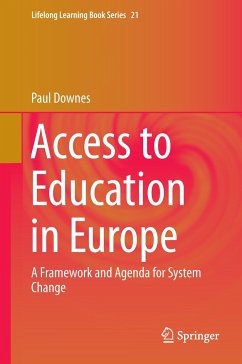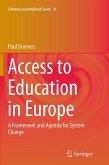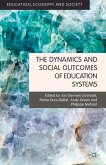- Gebundenes Buch
- Merkliste
- Auf die Merkliste
- Bewerten Bewerten
- Teilen
- Produkt teilen
- Produkterinnerung
- Produkterinnerung
This book identifies key elements of an international framework to develop systems-level change to promote access to education, including higher education, for socio-economically marginalized groups. It is based on interviews with senior government officials and senior management in universities, non formal education and prisons across 12 countries in Europe. The book identifies systemic obstacles to and opportunities for promotion of access to education for socio-economically excluded groups that are issues transferable to other countries' contexts. It adopts a systemic focus on access across…mehr
Andere Kunden interessierten sich auch für
![Access to Education in Europe Access to Education in Europe]() Paul DownesAccess to Education in Europe41,99 €
Paul DownesAccess to Education in Europe41,99 €![Education and Emancipation in the Neoliberal Era Education and Emancipation in the Neoliberal Era]() Noah De LissovoyEducation and Emancipation in the Neoliberal Era37,99 €
Noah De LissovoyEducation and Emancipation in the Neoliberal Era37,99 €![Intercultural Communication Education and Research Intercultural Communication Education and Research]() Hamza R'boulIntercultural Communication Education and Research159,99 €
Hamza R'boulIntercultural Communication Education and Research159,99 €![The Dynamics and Social Outcomes of Education Systems The Dynamics and Social Outcomes of Education Systems]() The Dynamics and Social Outcomes of Education Systems81,99 €
The Dynamics and Social Outcomes of Education Systems81,99 €![Critical Pedagogy in Uncertain Times Critical Pedagogy in Uncertain Times]() Critical Pedagogy in Uncertain Times25,99 €
Critical Pedagogy in Uncertain Times25,99 €![Foucault as Educator Foucault as Educator]() Stephen J. BallFoucault as Educator59,99 €
Stephen J. BallFoucault as Educator59,99 €![Christianity and Moral Identity in Higher Education Christianity and Moral Identity in Higher Education]() Perry L. GlanzerChristianity and Moral Identity in Higher Education31,99 €
Perry L. GlanzerChristianity and Moral Identity in Higher Education31,99 €-
-
-
This book identifies key elements of an international framework to develop systems-level change to promote access to education, including higher education, for socio-economically marginalized groups. It is based on interviews with senior government officials and senior management in universities, non formal education and prisons across 12 countries in Europe. The book identifies systemic obstacles to and opportunities for promotion of access to education for socio-economically excluded groups that are issues transferable to other countries' contexts. It adopts a systemic focus on access across a range of domains of education, both formal higher education and non-formal education, as well as prison education. Through a focus on a more dynamic structuralist systems framework it develops an innovative post-Bronfenbrennerian view of system levels in lifespan developmental and educational psychology. It also develops an international agenda for reform in relation to these various system levels for access to education for socio-economically marginalized groups, through extraction of key structural indicators to evaluate reform progress in a transparent, culturally sensitive manner. The book identifies current gaps and strengths in policy, practice and structures that impact upon access to education, including higher education, across a range of countries. These gaps and strengths are illustrative and are to inform a strategic approach to system level change and development for the promotion of access to education for socio-economically marginalized groups in Europe and beyond.
"Too many educational practices entrench social exclusion: it is an urgent priority across Europe that social justice policies are implemented for the inclusion of marginalised groups. Paul Downes' analysis of these issues is timely. His conclusions are considered and practical: this book is a valuable and constructive resource for practitioners, academics and the policycommunity." Professor Alistair Ross, Jean Monnet ad Personam Professor of Citizenship Education in Europe, Emeritus Professor of Education, Institute for Policy Studies in Education, London Metropolitan University
"Too many educational practices entrench social exclusion: it is an urgent priority across Europe that social justice policies are implemented for the inclusion of marginalised groups. Paul Downes' analysis of these issues is timely. His conclusions are considered and practical: this book is a valuable and constructive resource for practitioners, academics and the policycommunity." Professor Alistair Ross, Jean Monnet ad Personam Professor of Citizenship Education in Europe, Emeritus Professor of Education, Institute for Policy Studies in Education, London Metropolitan University
Produktdetails
- Produktdetails
- Lifelong Learning Book Series 21
- Verlag: Springer / Springer Netherlands
- Artikelnr. des Verlages: 978-94-017-8794-9
- 2014
- Seitenzahl: 288
- Erscheinungstermin: 13. Mai 2014
- Englisch
- Abmessung: 241mm x 160mm x 22mm
- Gewicht: 568g
- ISBN-13: 9789401787949
- ISBN-10: 9401787948
- Artikelnr.: 40356948
- Herstellerkennzeichnung Die Herstellerinformationen sind derzeit nicht verfügbar.
- Lifelong Learning Book Series 21
- Verlag: Springer / Springer Netherlands
- Artikelnr. des Verlages: 978-94-017-8794-9
- 2014
- Seitenzahl: 288
- Erscheinungstermin: 13. Mai 2014
- Englisch
- Abmessung: 241mm x 160mm x 22mm
- Gewicht: 568g
- ISBN-13: 9789401787949
- ISBN-10: 9401787948
- Artikelnr.: 40356948
- Herstellerkennzeichnung Die Herstellerinformationen sind derzeit nicht verfügbar.
Acknowledgements.-Foreword by Sue Waddington, President of the European Association for the Education of Adults (2008-2013).-1. Introduction: Developing a Conceptual Framework for Access to Education for Socio-Economically Marginalised Groups - A Systems Focus.-Chapter 1: Summary.- 2. System Blockages for Access to Education in Europe: Paper Commitments and Substantive Gaps.- 2.1 The European Union's strategic priority on paper of access and lifelong learning as a means of fostering social inclusion: Falling between two stools in the ET2020 targets ? .- 2.2 Access to education for marginalised groups: A neglected focus in university rankings.- Chapter 2: Summary.- 3. Conceptual Framework and Agenda: Beyond Bronfenbrenner (1979;1995) to Interrogation of Blocked Systems via Structural Indicators.- 3.1Conceptual Framework: Interrogating Bronfenbrenner's (1979; 1995) systems framework in educational, developmental and community psychology for access to education.-3.2 The need for focus on system blockage and displacement in moving from inert to inclusive systems: Key limitations to Bronfenbrenner's (1979; 1995) understanding of systems.- Chapter 3: Summary.- 4. Structural Indicators for System Level Change for Access to Education for Marginalised Groups.- 4.1 An agenda of structural indicators for system level change for access to education for marginalised groups at international, national and institutional levels.- 4.2 Key interpretative principles underpinning a systemic review of structural indicators for access to education derived by analogy from international rights discourse.- 4.3 Structural indicators: A key strategic gap in the OECD (Organisation for Economic Cooperation and Development) international education indicators.-Chapter 4: Summary.- 5. Access to Higher Education for Socio-Economically Marginalized Groups: Indicators at Macro-Exo levels.- 5.1 A central driving committee at State level for access to higher education andlifelong learning for marginalised groups (Structural Indicator) - including clear funding sources.- 5.2 Clarification of the criteria to ascertain socio-economic exclusion (Structural Indicator) given the observed tendency, especially in Central and Eastern European countries, for targeting to occur for more easily identifiable target groups like those with a disability or from an ethnic minority - in contrast with groups experiencing socio-economic exclusion.- Chapter 5: Summary.- 6. Access to Higher Education for Socio-Economically Marginalized Groups: Indicators at Macro-Exo levels.- 6.1 The need for a formal obligation on institutions from the State to improve access and for incentives for third level institutions such as differentiated funding from the State based on implementation of access goals (Structural Indicator).- 6.2 State-led incentives to different faculties and departments within third level institutions to increase access: A faculty and department level focus to increase access (Structural Indicator).- 6.3 An access strategy for the so-called 'elite' universities (Structural Indicator).- 6.4 Representation of target groups, including ethnic minorities in the decision making structures and processes at national level regarding access to education (Structural Indicator).- 6.5 A system of reserved places or equivalent approach to increase participation of underrepresented groups at third level (Structural Indicator).- 6.6 A coherent support strategy for access to third level education for orphans and young people in care (Structural Indicator).- Chapter 6: Summary.- 7.Access to Higher Education for Socio-Economically Marginalized Groups: Indicators at Micro-Meso levels.- 7.1 Education institutional strategies for access for groups experiencing socio-economic exclusion (Structural Indicator).- 7.2 Development of outreach institutional strategies that go beyond mere information based models (Structural Indicator).- 7.3 Availability of schooland university institutions free of charge during summertime and evenings for community groups from marginalised areas (Structural Indicator).- 7.4 Outreach strategy to communicate with spokespersons, opinion makers and community leaders in socio-economically marginalised or ethnic minority communities (Structural Indicator).- 7.5 Formal links between universities and Non-Governmental Organisations representing marginalised groups (Structural Indicator).- 7.6 Outreach strategy to engage young immigrants and young members of a target group: Cohort effect as a positive potential (Structural Indicator) .- 7.7 An access strategy of third level institutions which engages with primary and secondary students experiencing socio-economic marginalisation (Structural Indicator) .- 7.8 Preparatory admission courses (Structural Indicator).- 7.9 Challenge to institutional staff attitudes.- Chapter 7: Summary.- 8. Non-formal education: Indicators at Macro-Exo levels.- 8.1 Introduction: Non-formal education as a key path to overcoming fear of failure in marginalised groups.- 8.2 The need for a national and regional strategy for non-formal education -to relate but not reduce non-formal education to the formal system (Structural Indicator).- 8.3 The need for agreed, nonreductionist, accountability processes in the non-formal sector: Due to less accountability provided by non-formal educational institutions in a climate of increasing need for accountability (Structural Indicator) .- 8.4 Funded strategies to develop local community lifelong learning centres (Structural Indicator).- 8.5 Non-formal education as a key bridge to ethnic minorities, immigrants and those experiencing social exclusion.- Chapter 8: Summary.- 9. Non-formal Education: Indicators at Micro-Meso Levels.- 9.1 A strategy to develop community leaders (Structural Indicator) .- 9.2 National strategies for lifelong learning to include the arts as a key bridge into societal and systemic participationvia non-formal education (Structural Indicator).- 9.3 Non-formal as a path to formal education (Structural Indicator).- 9.4 Staff continuity and development in non-formal education (Structural Indicator).- 9.5 Pathways to overcome process difficulties regarding recognition of prior learning.- Chapter 9: Summary.- 10. Prison Education: Indicators at Macro-Exo Levels.- 10.1 Introduction: Prison education as a domain of lifelong learning .- 10.2 A national strategy of education for prisoners (Structural Indicator).- 10.3 Opportunities for distance education and web-based learning in prison(Structural Indicator).-10.4 An education strategy for high security prisons (Structural Indicator).- 10.5 Overcoming ambivalence from prison officers in some countries to prisoner Learning.- Chapter 10: Summary.- 11. Prison education: Indicators at Micro-Meso levels.- 11.1 Establishment and implementation of a principle of normality in prisons (Structural Indicator).- 11.2 Individual education plans for prisoners (Structural Indicator).- 11.3 Initial assessment approaches for prisoners (Structural Indicator).- 11.4 Sufficient space in prison for education (Structural Indicator).- 11.5 Professional development support and resource materials for teachers in prisons (Structural Indicator).- 11.6 Prisoner exchange based on educational reasons, including bridges to external education institutions (Structural Indicator).- 11.7 Overcoming practical problems to allow the prisoner to study in prison and at third level.- 11.8 Peer effects on motivation to learn in prison.- Chapter 11: Summary.- 12. Conclusion.- 12.1 Developing a European Union agenda of structural indicators for access to higher education and lifelong learning for socioeconomically excluded groups.- 12.2 Developing a conceptual framework to move from blocked systems of exclusion towards systems of inclusion for access to higher education and lifelong learning: From diametric to concentric systems of relation.- Chapter12: Summary.- Appendix A: Glossary of key terms.- Appendix B: Illustrative examples of a Structural Indicators Matrix Tool for Access to Education for Socio-Economically Marginalised Groups: Higher education, Non-Formal education, Prison education.
Acknowledgements.-Foreword by Sue Waddington, President of the European Association for the Education of Adults (2008-2013).-1. Introduction: Developing a Conceptual Framework for Access to Education for Socio-Economically Marginalised Groups - A Systems Focus.-Chapter 1: Summary.- 2. System Blockages for Access to Education in Europe: Paper Commitments and Substantive Gaps.- 2.1 The European Union's strategic priority on paper of access and lifelong learning as a means of fostering social inclusion: Falling between two stools in the ET2020 targets ? .- 2.2 Access to education for marginalised groups: A neglected focus in university rankings.- Chapter 2: Summary.- 3. Conceptual Framework and Agenda: Beyond Bronfenbrenner (1979;1995) to Interrogation of Blocked Systems via Structural Indicators.- 3.1Conceptual Framework: Interrogating Bronfenbrenner's (1979; 1995) systems framework in educational, developmental and community psychology for access to education.-3.2 The need for focus on system blockage and displacement in moving from inert to inclusive systems: Key limitations to Bronfenbrenner's (1979; 1995) understanding of systems.- Chapter 3: Summary.- 4. Structural Indicators for System Level Change for Access to Education for Marginalised Groups.- 4.1 An agenda of structural indicators for system level change for access to education for marginalised groups at international, national and institutional levels.- 4.2 Key interpretative principles underpinning a systemic review of structural indicators for access to education derived by analogy from international rights discourse.- 4.3 Structural indicators: A key strategic gap in the OECD (Organisation for Economic Cooperation and Development) international education indicators.-Chapter 4: Summary.- 5. Access to Higher Education for Socio-Economically Marginalized Groups: Indicators at Macro-Exo levels.- 5.1 A central driving committee at State level for access to higher education andlifelong learning for marginalised groups (Structural Indicator) - including clear funding sources.- 5.2 Clarification of the criteria to ascertain socio-economic exclusion (Structural Indicator) given the observed tendency, especially in Central and Eastern European countries, for targeting to occur for more easily identifiable target groups like those with a disability or from an ethnic minority - in contrast with groups experiencing socio-economic exclusion.- Chapter 5: Summary.- 6. Access to Higher Education for Socio-Economically Marginalized Groups: Indicators at Macro-Exo levels.- 6.1 The need for a formal obligation on institutions from the State to improve access and for incentives for third level institutions such as differentiated funding from the State based on implementation of access goals (Structural Indicator).- 6.2 State-led incentives to different faculties and departments within third level institutions to increase access: A faculty and department level focus to increase access (Structural Indicator).- 6.3 An access strategy for the so-called 'elite' universities (Structural Indicator).- 6.4 Representation of target groups, including ethnic minorities in the decision making structures and processes at national level regarding access to education (Structural Indicator).- 6.5 A system of reserved places or equivalent approach to increase participation of underrepresented groups at third level (Structural Indicator).- 6.6 A coherent support strategy for access to third level education for orphans and young people in care (Structural Indicator).- Chapter 6: Summary.- 7.Access to Higher Education for Socio-Economically Marginalized Groups: Indicators at Micro-Meso levels.- 7.1 Education institutional strategies for access for groups experiencing socio-economic exclusion (Structural Indicator).- 7.2 Development of outreach institutional strategies that go beyond mere information based models (Structural Indicator).- 7.3 Availability of schooland university institutions free of charge during summertime and evenings for community groups from marginalised areas (Structural Indicator).- 7.4 Outreach strategy to communicate with spokespersons, opinion makers and community leaders in socio-economically marginalised or ethnic minority communities (Structural Indicator).- 7.5 Formal links between universities and Non-Governmental Organisations representing marginalised groups (Structural Indicator).- 7.6 Outreach strategy to engage young immigrants and young members of a target group: Cohort effect as a positive potential (Structural Indicator) .- 7.7 An access strategy of third level institutions which engages with primary and secondary students experiencing socio-economic marginalisation (Structural Indicator) .- 7.8 Preparatory admission courses (Structural Indicator).- 7.9 Challenge to institutional staff attitudes.- Chapter 7: Summary.- 8. Non-formal education: Indicators at Macro-Exo levels.- 8.1 Introduction: Non-formal education as a key path to overcoming fear of failure in marginalised groups.- 8.2 The need for a national and regional strategy for non-formal education -to relate but not reduce non-formal education to the formal system (Structural Indicator).- 8.3 The need for agreed, nonreductionist, accountability processes in the non-formal sector: Due to less accountability provided by non-formal educational institutions in a climate of increasing need for accountability (Structural Indicator) .- 8.4 Funded strategies to develop local community lifelong learning centres (Structural Indicator).- 8.5 Non-formal education as a key bridge to ethnic minorities, immigrants and those experiencing social exclusion.- Chapter 8: Summary.- 9. Non-formal Education: Indicators at Micro-Meso Levels.- 9.1 A strategy to develop community leaders (Structural Indicator) .- 9.2 National strategies for lifelong learning to include the arts as a key bridge into societal and systemic participationvia non-formal education (Structural Indicator).- 9.3 Non-formal as a path to formal education (Structural Indicator).- 9.4 Staff continuity and development in non-formal education (Structural Indicator).- 9.5 Pathways to overcome process difficulties regarding recognition of prior learning.- Chapter 9: Summary.- 10. Prison Education: Indicators at Macro-Exo Levels.- 10.1 Introduction: Prison education as a domain of lifelong learning .- 10.2 A national strategy of education for prisoners (Structural Indicator).- 10.3 Opportunities for distance education and web-based learning in prison(Structural Indicator).-10.4 An education strategy for high security prisons (Structural Indicator).- 10.5 Overcoming ambivalence from prison officers in some countries to prisoner Learning.- Chapter 10: Summary.- 11. Prison education: Indicators at Micro-Meso levels.- 11.1 Establishment and implementation of a principle of normality in prisons (Structural Indicator).- 11.2 Individual education plans for prisoners (Structural Indicator).- 11.3 Initial assessment approaches for prisoners (Structural Indicator).- 11.4 Sufficient space in prison for education (Structural Indicator).- 11.5 Professional development support and resource materials for teachers in prisons (Structural Indicator).- 11.6 Prisoner exchange based on educational reasons, including bridges to external education institutions (Structural Indicator).- 11.7 Overcoming practical problems to allow the prisoner to study in prison and at third level.- 11.8 Peer effects on motivation to learn in prison.- Chapter 11: Summary.- 12. Conclusion.- 12.1 Developing a European Union agenda of structural indicators for access to higher education and lifelong learning for socioeconomically excluded groups.- 12.2 Developing a conceptual framework to move from blocked systems of exclusion towards systems of inclusion for access to higher education and lifelong learning: From diametric to concentric systems of relation.- Chapter12: Summary.- Appendix A: Glossary of key terms.- Appendix B: Illustrative examples of a Structural Indicators Matrix Tool for Access to Education for Socio-Economically Marginalised Groups: Higher education, Non-Formal education, Prison education.








